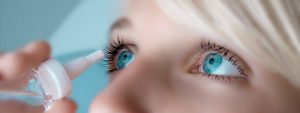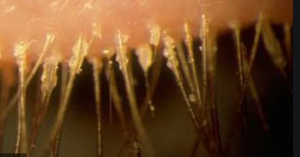Over 58% of the population suffer from dry eyes.
Dry eyes is a common condition that results from insufficient tear quantity, or inadequate tear quality.
Dry eyes can range from a mild inconvenience to a chronic problem, and cause many uncomfortable symptoms that can impact your performance of daily activities.
- 58% of people suffer from mild symptoms.
- 30% of people suffer from moderate dry eye.
- 12% of people suffer from severe dry eyes.
The following statistics indicate that the prevalence of the condition varies based on gender and age:
- Women: approximately 11 million (8.8%)
- Men: approximately 5.3 million (4.5%)
- 18-34 years: 2.7%
- Over 34 years: 18.6%
What causes dry eyes?
First, let’s understand how tears work.
When we blink, our tears spread across the front surface of our eyes. The tears function to lubricate our eyes, and to wash away any foreign matter— keeping our eyes clear and reducing the risk of eye infection. Excess tears flow into small ducts in the inner corners of the eyelids where they drain out of the eyes and into the back of the nose.
Tears are made up of three important layers.
Tears consist of three layers that function to protect and nourish the surface of the eye. If there is a problem with any of these layers, symptoms of dry eye can develop.
- Oil layer– prevents evaporation of the water layer
- Water layer– sustains the eye
- Mucous layer– spreads tears to cover the entire surface of the eye
Types of dry eyes
Dry eyes can occur as a result of the following:
- Meibomian gland dysfunction occurs when the meibomian glands don’t produce enough oil (meibum), which causes the tears to evaporate too rapidly.
- Aqueous deficient dry eye occurs when the lacrimal glands don’t produce enough liquid (aqueous) to keep the eyes sufficiently moistened.
Keratoconjunctivitis sicca (KCS) is the most common cause of dry eyes that occurs when there is an insufficient amount of tears. If there is an imbalance between the quantity of tears, and the rate at which the tears evaporate, dry eye symptoms can develop.
Symptoms of dry eyes
- Dry, irritated, or red eyes
- Inflammation or burning
- Itchiness
- Excessive tearing/watery eyes
- Blurriness
- Sensitive or sore eyes
- Eyelid discomfort
- Foreign body sensation
If you suffer from any of these dry eye syndrome symptoms contact an eye doctor near you to give your eyes relief.
SEE RELATED: Why is Dry Eye Worse in the Mornings?
Factors that can increase your risk of dry eyes
- Poor tear quality or quantity
- Gender— women at a higher risk from hormonal changes (pregnancy, oral contraceptives, menopause)
- Age – over age 50
- Environmental factors and irritants—smoke, wind and dry climates
- Medical conditions – diabetes, rheumatoid arthritis, and thyroid problems
- Medications – decongestants, antihistamines, anti-depressants and blood pressure medications
- Lifestyle factors—high BMI, unhealthy diet or low daily water consumption
- Extended screen use – using digital screens for hours per day
- Contact lenses— poorly fitting, outdated prescription or long term use
- Meibomian gland disorder – insufficient production or secretion of oil into the tears
- Blepharitis – clogged oil glands in eyelid
- Refractive eye surgeries – LASIK
How are dry eyes diagnosed?
Dry eyes are diagnosed through a comprehensive eye exam. Your eye doctor will examine your eyes, including your eyelids and cornea, and evaluate your blink dynamics using a bright light and magnification.
The tear breakup time (TBUT) test is a painless procedure that is commonly used to determine the stability of your tear film. This test involves placing a drop of dye on the front surface of your eye to be absorbed by the tear film.
Your doctor will then examine your eye with a blue light which causes your tears to glow. If your tear film has reduced stability, the tears will break up quickly on your eye. This dye also highlights any problems on the eye’s surface that have been caused by insufficient tears.
How are dry eyes treated?
There are many different treatments for dry eyes. Your eye doctor will determine the most appropriate treatment depending on the severity of the condition.
Treatments for mild symptoms:
1. Lubricating eye drops/Artificial tears solution. When symptoms are mild, many people will feel relief from regular use of lubricating eye drops called artificial tears. These eye drops are over-the-counter, and may be used as often as needed.
Many eye doctors recommend preservative-free artificial tears solutions because those with preservatives may further irritate your eyes.
2. Warm compresses. Relax with a warm compress to cleanse your eyelids and improve oil flow through your eyelid glands. This will help to improve the quality of your tears and alleviate dry eyes.
3. Rinse your eyelids. Gently massage your eyelids with warm water and baby shampoo to further improve oil flow through your eyelid glands and the quality of your tears. A preservative-free eyelid cleanser may also be used. Remember to clean both your upper and lower eyelids, as well as your eyelashes, to remove any makeup or creams that may irritate your eyes.
4. Lifestyle changes. Avoid triggers that can cause dry eyes, such as alcohol, smoking, and dry/windy climates. If you cannot avoid these triggers completely, wear protective sunglasses or eyewear that can shield your eyes when venturing outdoors.
5. Omega-3 supplements. Add omega-3 fatty acids to your diet— Omega-3 is most commonly found in fish and flax seeds, and have been proven to decrease symptoms of dry eyes. Omega-3 reduces inflammation in the eyes and enables increased tear quantity as well as quality!
Treatments for moderate symptoms:
1 Ointments/gels. If your eyes are severely dry, lubricating artificial tears ointment or gel may be more effective than eye drops. Ointments and gels provide moisture and relief for a longer period of time. However, it is recommended to only use ointments or gels before bedtime because they may cause blurry vision for a short time after application.
2. Punctal plugs. In some cases, if your tears are draining too quickly, your eye doctor may recommend a procedure that involves blocking the tear ducts from draining the tears, in order to preserve your natural tears. There are two types of punctal plugs:
- Permanent- made of non-absorbent material, such as silicone.
- Temporary- made of collagen which is eventually absorbed by the body. These plugs are typically effective for several months.
3. Blephasteam. Blephasteam delivers moisture and heat therapy through a specialized warming device. This procedure opens the meibomian glands to increase tear quality, decrease tear evaporation, and improve vision.
Blephasteam is also effective for treatment of meibomian gland dysfunction, posterior blepharitis, ocular rosacea, chalazion, and contact lens intolerance.
4. Blephex. This in-office procedure relieves chronic dry eye symptoms by eliminating the bacterial debris from the eyelids— the primary cause of blepharitis, an inflammatory eyelid disease. When the inflammation is treated, your overall eyelid health can improve. Blephex treatments facilitate increased tear production and reduce uncomfortable symptoms associated with blepharitis and dry eye syndrome.
5. Sleep goggles and moisture chamber glasses. These protective eyewear options help to keep your eyes moist by reducing evaporation of tears, and protecting your eyes from irritants such as allergens and dust.
Treatment for severe symptoms
1 Restasis prescription eye drops. When dry eye symptoms are severe, an artificial tears solution may not be strong enough. In this case, your eye doctor will give you a prescription for medicated eye drops that can facilitate increased production of tears.
2. Steroid eye drops. In some severe cases, steroid eye drops are prescribed, usually in combination with medicated eye drops. These drops function to reduce inflammation, thereby improving tear flow.
3. LipiFlow thermal pulsation system. LipiFlow has revolutionized dry eye treatment, relieving symptoms in 86% of dry eye patients.
LipiFlow is a procedure used to open the meibomian glands for improved natural production of lipids (oil), necessary to reduce evaporation of tears.
During a LipiFlow procedure, an eyepiece called the activator, is worn by the patient while controlled heat and adaptive pressure is applied to the inner eyelid. This process encourages increased production of lipids essential for your tear film.
4. Intense pulsed light (IPL). Lumenis M22 IPL uses a special light that causes the blood vessels in the eyes to open for light absorption, coagulate, and then close. This process decreases both inflammation and bacterial overgrowth— treating meibomian gland dysfunction, a common underlying cause of dry eyes. Four treatments are generally required to see optimal results.
5. Eyelid surgery. In most cases, surgery for dry eyes is not indicated. In rare cases, dry eyes can result from lower eyelids that are too loose— causing an increased rate of tear drainage. In this case, eyelid surgery may be recommended.
How can I prevent dry eyes in the future?
Prevent dry eye symptoms before they begin by following these suggestions:
1. Make lifestyle adjustments
- Abide by the 20-20-20 rule during prolonged computer use— take breaks every 20 minutes, to look at an object that is 20 feet away, for 20 seconds
- Blink frequently during prolonged computer use
- Increase humidity in the air at home, and at work
- Avoid products that contain eye irritants
- Limit alcohol consumption
- Quit smoking
- Wear protective sunglasses when going outdoors
- Use lubricating eye drops if you are taking medication that can increase your risk for dry eyes
2. Stay hydrated
Drink enough water throughout the day (at least 8 cups) to ensure that your eyes produce enough tears to combat dry eyes. This is especially important in hot or dry climates.
3. Consume a healthy diet including Omega-3
Omega 3 fatty acids (found in fish and flax seeds) have been proven to help maintain ocular health and clear vision, as well as decrease symptoms of dry eyes.
LEARN MORE: Guide to Eye Conditions
If you are experiencing symptoms of dry eyes, schedule an appointment with an eye doctor to determine the best possible treatment plan for you.
Taking care of your eyes is essential to your health and well being.










